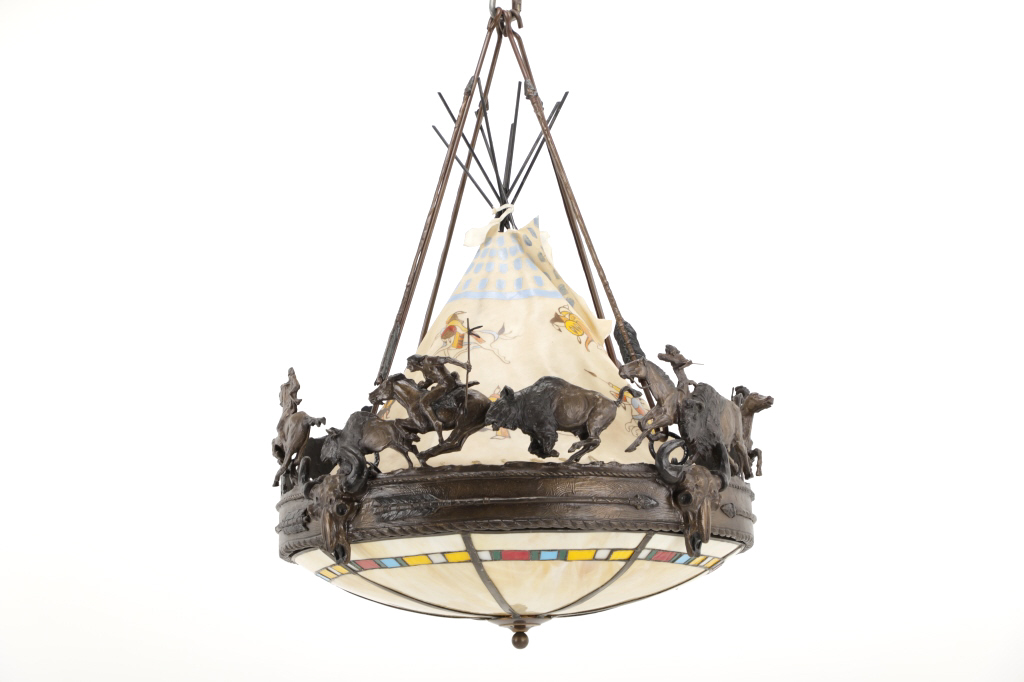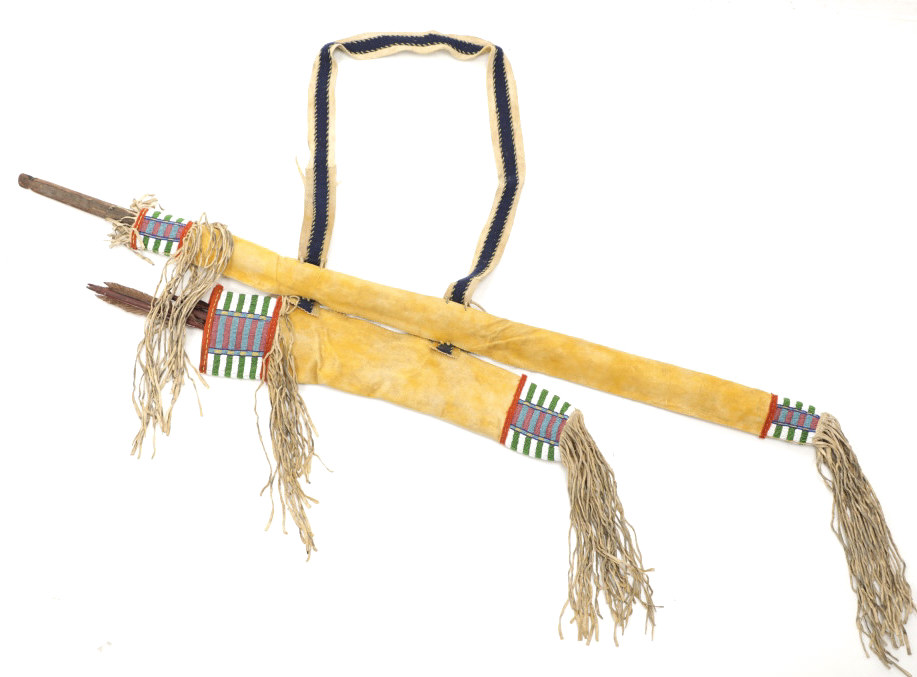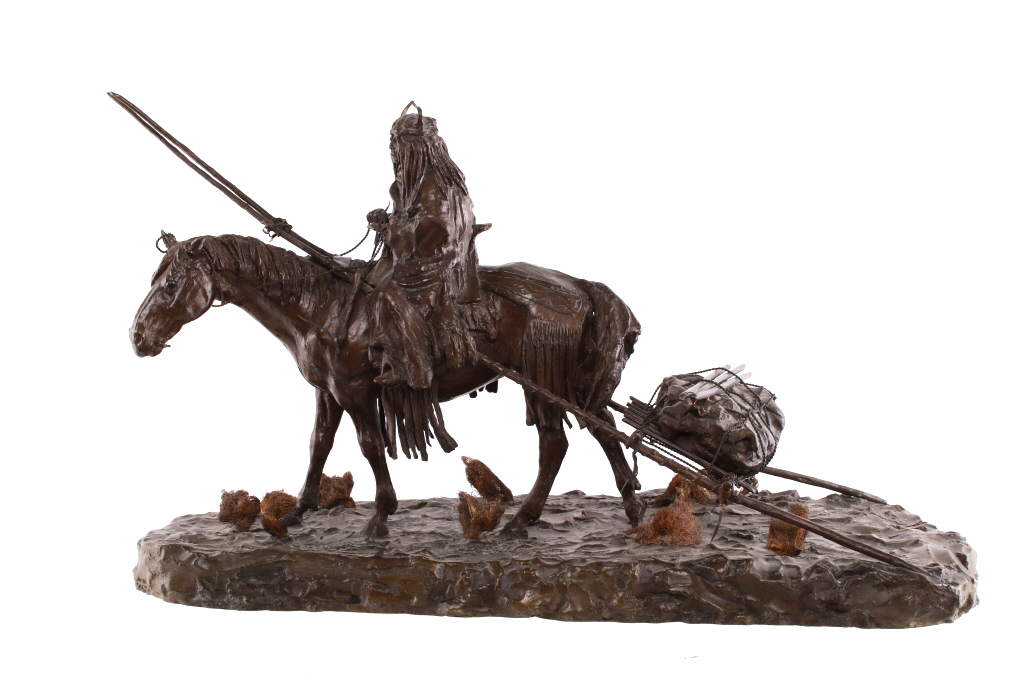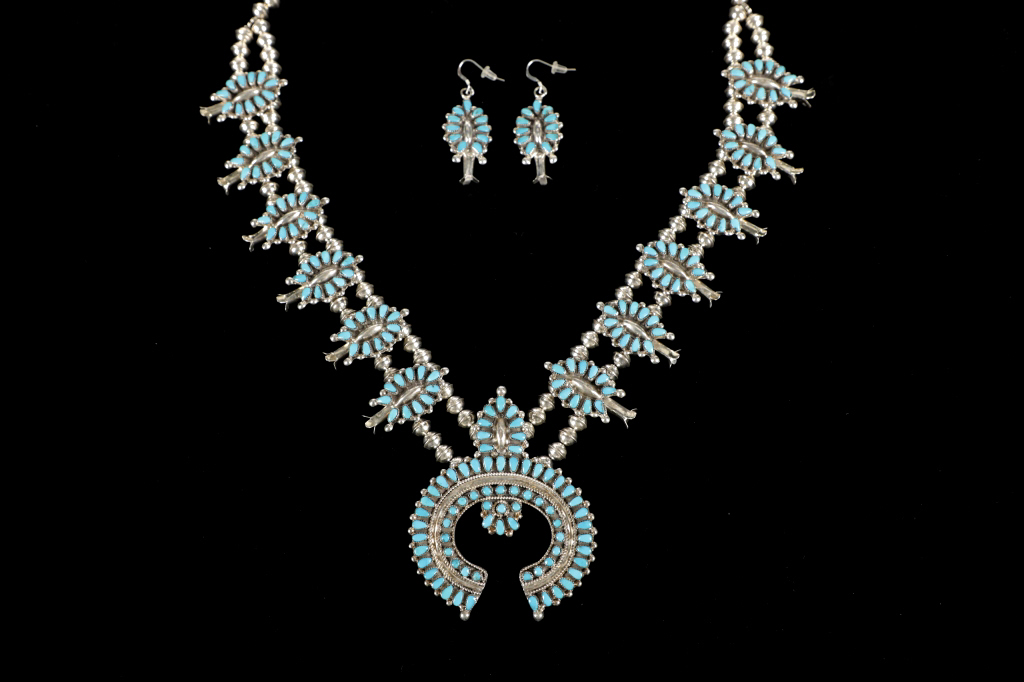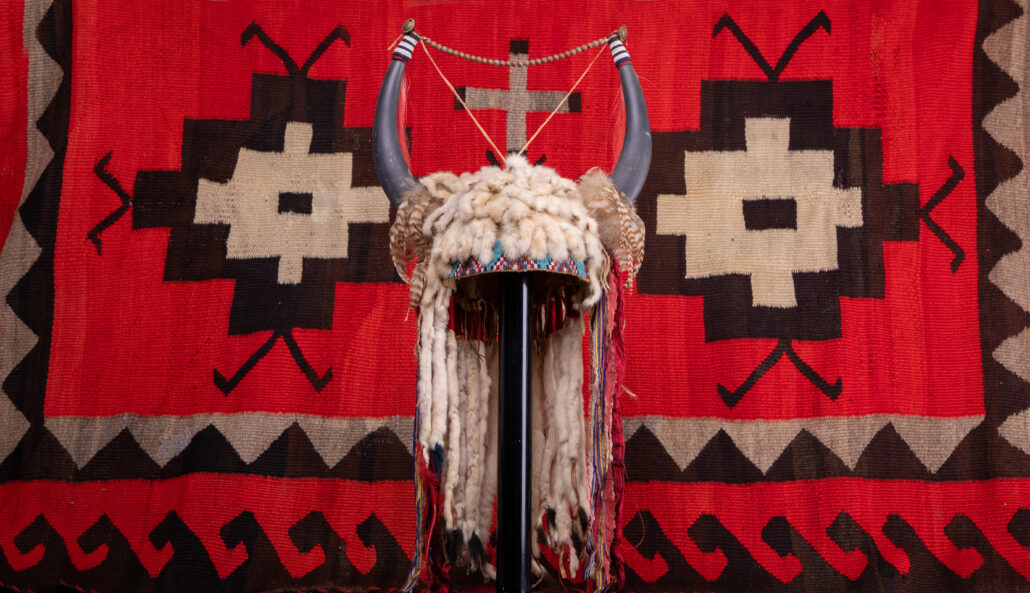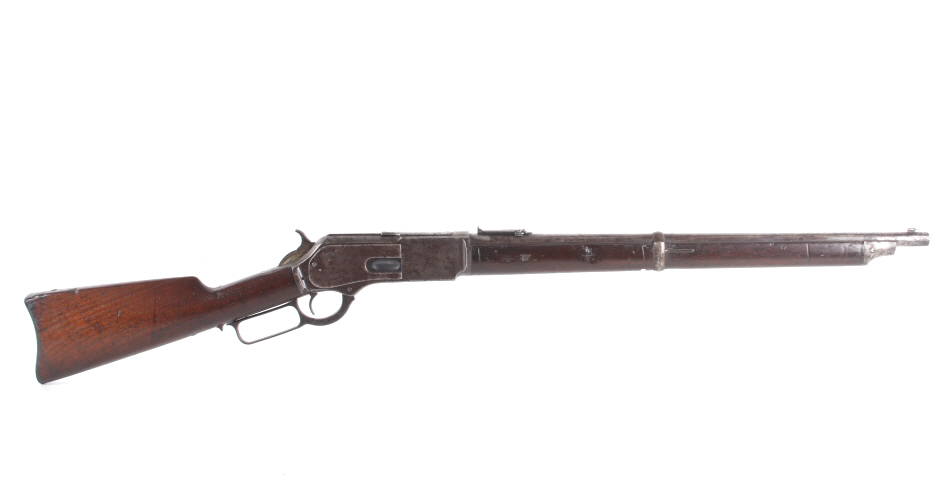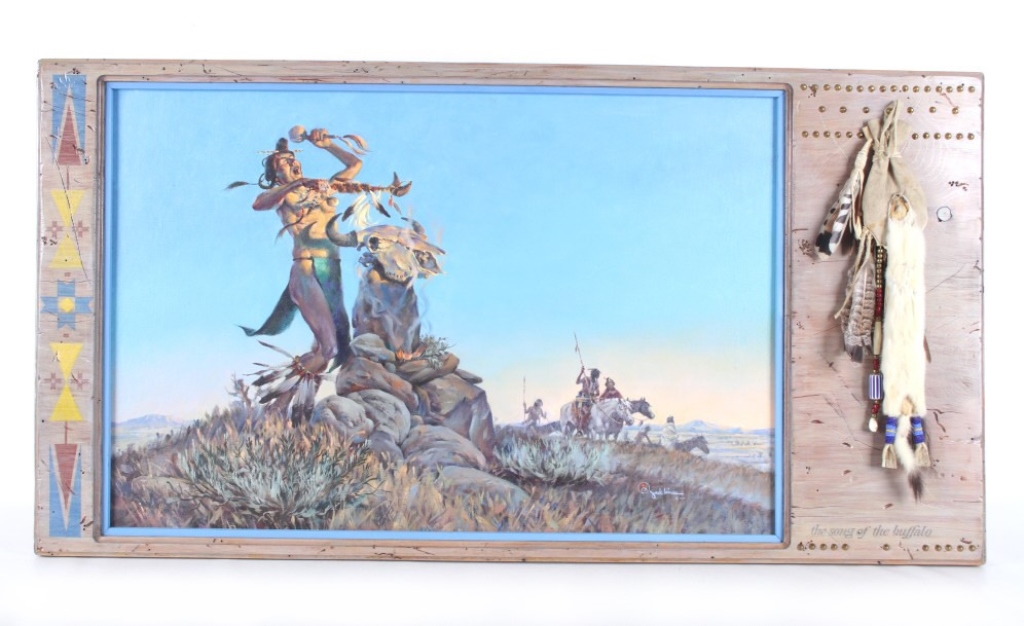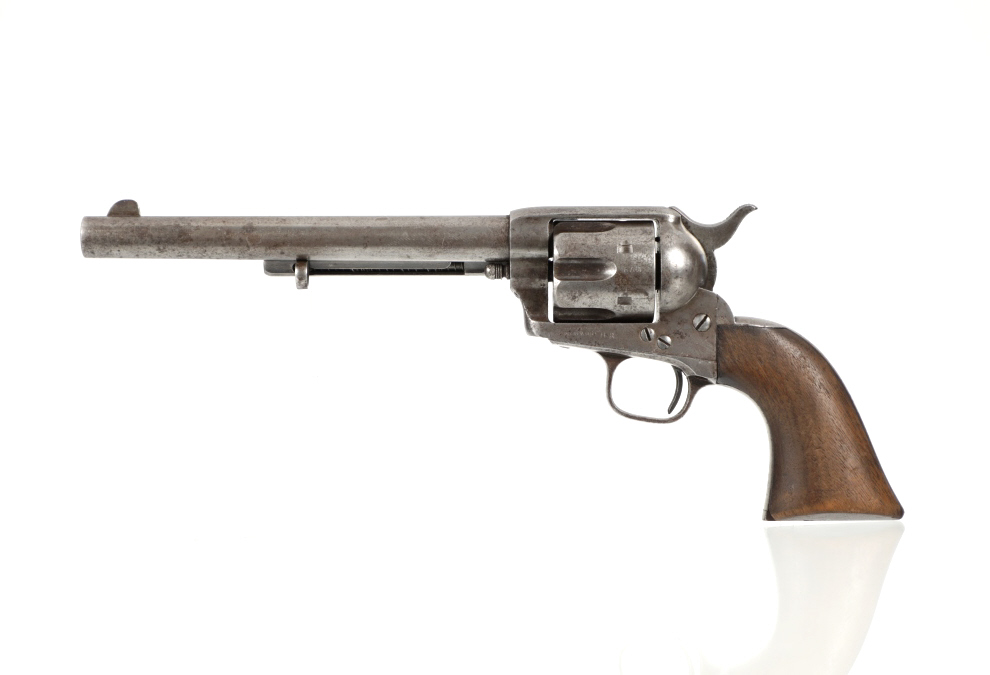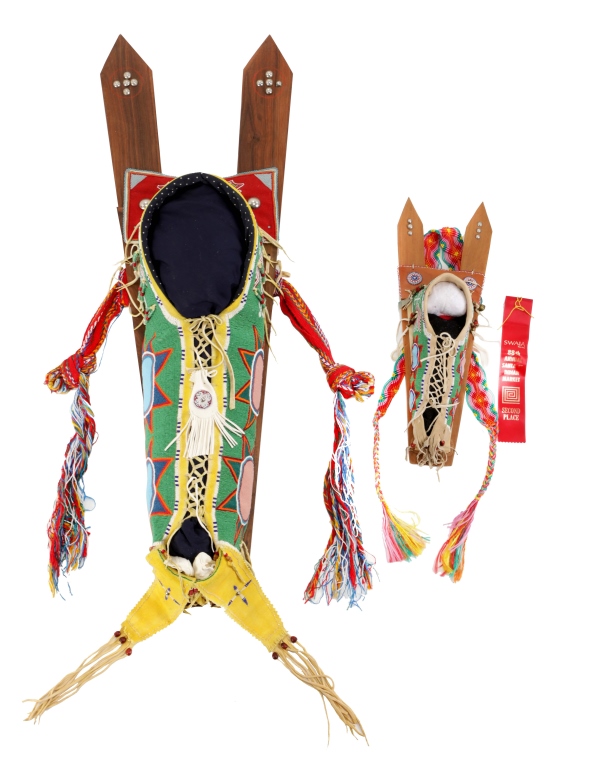Peter M. Fillerup (September 4, 1953 – August 2016) was an American sculptor. He was trained by Utah sculptor Avard Fairbanks. He designed a sculpture of Porter Rockwell, who served on the Council of Fifty, as well as lighting fixtures for 20 LDS temples, including the Payson Utah Temple and the Lima Peru Temple. In 1997, he designed the Hilda Erickson Memorial Statue, a public statue in memory of all American pioneers in Grantsville, Utah.
The lot features a solid bronze original work of art sculpture chandelier showing a thick bronze ring with horseback Native American warrior hunting a Great American Bison Buffalo. The top shows a parfleche tent and the bottom a stained glass shade. Truly one of the most unique and amazing pieces in the sale.
Item link.
This is an exceptional example of a bow, arrow and quiver set, quite possibly the best we have ever offered, an authentic circa 1870 Southern Cheyenne beaded quiver set from the Mary Lou and Pierre DuPont family collection out of St. Louis, Missouri. The set is made of Indian brain-tanned Buffalo Bison hide and is covered in hand-rubbed yellow ocher / ochre mineral pigment dye. The quiver has beautifully beaded sections in typical 19th Century Cheyenne colors and the traditional Cheyenne “bar” designs. The beadwork is all period glass trade seed beads in colors of greasy blue, greasy yellow, semi-transparent rose, semi-transparent green and greasy / chalk white. In addition to the wonderful beadwork, the quiver shows various sections of Indian tanned frilly hide fringes as well as a strip of old stroud trade cloth on the outer side. There are some minor and expected stains and discoloration of the fringes and hide. The set is sinew sewn and expertly crafted with exceptional art appeal.
To view more images and to see a complete overview of the item and its owner please follow the link.
Robert Macfie Scriver (1914–1999) was a Montana sculptor who was born on the Blackfeet reservation of Anglophone Quebec parents. Scriver was a scholar of Blackfoot Indian culture and history who knew and associated with Blackfoot historian James Willard Schultz in the earlier part of his life.
The bronze is marked as follows: The Holy Woman – Bob Scriver – 1977 – 5/40. The sculpture features a wonderfully and professionally crafted bronze construction that shows a holy woman riding a horse and moving her tent and living materials on a the back load of the caravan. There is great attention to the face of the woman and to horse carrying the burden.
This piece is one of Robert Scriver’s larger bronzes and uncommonly seen. Follow the link for more info.
This is a unique pipe tomahawk attributed to the Cheyenne Indians of Wyoming showing a triple cut out, originally from the Ted and Lilly Jarvis collection from Jackson Hole and Jim Bastian estate in Kansas City, Missouri. The piece exhibits a large, heavy example with rare and unique artful triple cut out at the center of the blade. The tomahawk is blacksmith forged iron and shows three bleeder holes pierced into it, forged chevrons, forged moldings and an artful, vase-shaped pipe bowl with filed rings. The hardwood haft handle has old brass trade tacking of various sizes, and a later drop of horse tail hair and hawk bell dangle tie onto the bottom. There are faint, old hot file brandings on the haft and some marks. This is considered a stylized version of the “batwing” cut out. A similar example is pictured in the hands of a Cheyenne Indian shown on page 80 of John Baldwin’s 2001 book “Indian War Clubs of the American Frontier”.
Click the link for more info.
This is an outstanding, sale highlight set showing a fine Sleeping Beauty Turquoise petit point squash blossom and earrings from renowned silversmith artist husband and wife, Maryann and Felix Chavez of the Zuni Pueblo. The necklace and earrings show the correct hallmark showing a stylized M with and F / C incorporated into the right side of the M text line over top of STERLING (also referred to as offset joined initials). The set is in pristine condition with fine gem quality Sleeping Beauty Mine Turquoise on sterling silver.
Large sets such as this are scarce from Maryann and Felix Chavez with this truly being one of the best sets.
For more info visit the link.
This is an outstanding beaded war bonnet headdress with split Buffalo Bison horns and “wormy” ermines dating to circa 1890-1900’s from the Blackfoot / Blackfeet Native American Indians of the Northern Plains of Canada. The piece was purchased from Allard Auction in November 2002 where it had a $6,000 high value and has since been on display in a prominent Native American and Western / Wildlife art collection.
This set is truly a sale highlight and was one of the center pieces from the Lowell Baier collection. For more info click the link.
In this lot is an exceedingly rare Winchester Model 1876 Saddle Ring Carbine. Nearly the entire production of the big Model 1876 Winchester was devoted to rifle manufacture. There was a considerable contract for carbines from the Canadian Northwest Mounted Police, but aside from these historic arms, Winchester made carbines for the civilian market on a very limited basis. Total production of all Model 1876s from 1876 to its discontinuance in 1888 (with about 300 additional arms made intermittently to 1898) was a mere 63,871.
Click the link for more info.
Jack Hines was an American artist who was born in 1923 and died in 2015.
Featured in this lot is an oil on board called “The Song of the Buffalo” from artist Jack Hines who was born in 1923. The painting shows a wonderfully and professionally crafted oil painting with a Native American man with dancing wands rotating around a skull totem. The painting shows a medicine bag with a feather and a a hide with rounds of dark blue and light blue trade seed beads attached to the legs of the hide. The artist’s signature is shown in the right hand corner of the oil panting.
For more info click the link.
The Battle of the Little Bighorn, or known to the Lakota and other Plains Indians as the Battle of the Greasy Grass, is the most iconic battle of the “Indian Wars” and “Great Sioux Sioux War of 1876 (or) Black Hills War”. Items with any association with this battle are widely considered some of the most important and historic of the era being majorly in the collections of museums and institutions.
On this rare occasion one of these rare objects is being brought to the public market, this original U.S. Colt from Surgeon J.M. DeWolf.
Not only does this significant piece bare the initials of Surgeon J.M. DeWolf being marked SJMD, the piece is marked extensively with Lakota Togia language and is accompanied by a signed historical examination documenting the pieces important history.
Item link.
Vanessa (Nesha) Paukeigope Jennings (Kiowa, born 1952) is recognized as the last cradleboard maker among her Kiowa people and one of the few artists who still brain-tans her own hides.
Vanessa, an enrolled Kiowa tribal elder, was awarded the National Heritage Fellowship in 1989 by The National Endowment for the Arts, a lifetime honor presented to master folk and traditional artists and is the United States’ highest honor in the folk and traditional arts. This award automatically qualifies her as a Living National Treasure by the U.S. Congress and the President.
Offered is, by her own words, one of her best crafted full size and doll cradle boards done in classic Kiowa tradition. Now is your chance to own works similar to that hanging in the halls of the Smithsonian, Buffalo Bill Center, and National Cowboy Museum.
The cradle board is accompanied by a signed letter from the artist directly. Sadly due to health reasons Vanessa is no longer creating works of art such as this, given that she is one of the last Kiowa to create pieces in the original tradition that makes this set truly a historic and important work.
To view more images and to see a complete overview of the item and its owner please follow the link.

